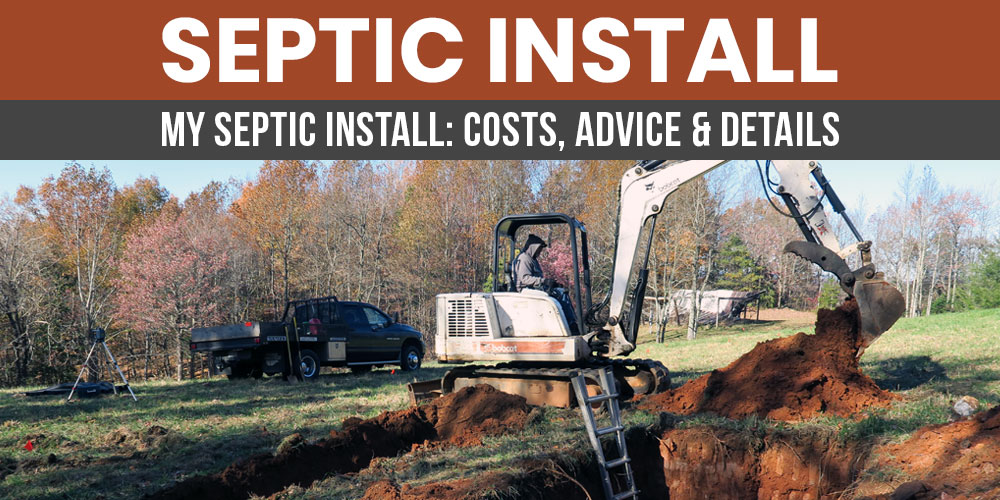 If you’re anything like me, a home in the mountains or in the countryside has been a dream for a very long time. Having lived in the city where municipal sewer was available, I didn’t have to worry about such things. After I bought my land in the mountains of NC, I knew getting a septic system installed would be a necessity. Having just finished up getting my septic tank installed, I wanted to share my experience, the cost and other info for those who are doing the same thing
If you’re anything like me, a home in the mountains or in the countryside has been a dream for a very long time. Having lived in the city where municipal sewer was available, I didn’t have to worry about such things. After I bought my land in the mountains of NC, I knew getting a septic system installed would be a necessity. Having just finished up getting my septic tank installed, I wanted to share my experience, the cost and other info for those who are doing the same thing
The land I bought is going to serve two purposes for me. The first being wanted a place I could move my tiny house in the future if I ever needed to. Having a piece of land with power, a well and a septic system for my tiny house would make it easy to roll up and connect. The second reason is, while I love my tiny house, it’s not my forever house. At some point I’m going to build a small home and this land is the perfect place.
What Is A Septic Tank?

Let’s start with the basics. A septic tank is a sealed reservoir that’s buried and collects waste water. The solids will settle out, grease will rise and filtered liquids will flow out into a leach field. This allows you to safely collect, filter and distribute your black and grey water from your home. Over time, solids will collect in the tank and it will need to be cleaned.
Do I Need Permission For A Septic Tank? Permits?

Yes, septic tanks in many countries are regulated to ensure public safety. In the United States, most permits for septics are issued through the state Department of Health.
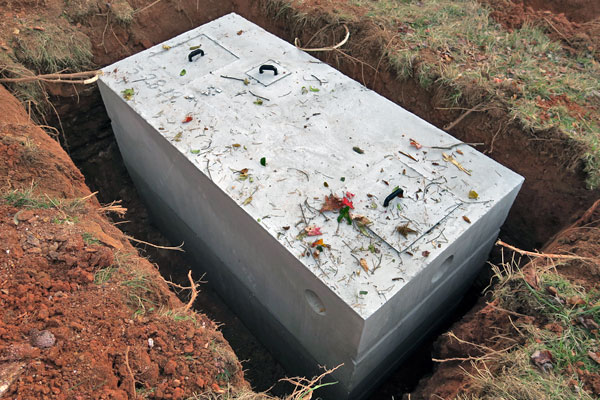 Setting aside the debate of smaller vs. larger government, the aim of this is to make sure that the septic field is installed properly and to make sure the ground water isn’t contaminated. This is something I can get behind, considering I’d like to know if my neighbors unmitigated sewage is seeping directly into my ground water.
Setting aside the debate of smaller vs. larger government, the aim of this is to make sure that the septic field is installed properly and to make sure the ground water isn’t contaminated. This is something I can get behind, considering I’d like to know if my neighbors unmitigated sewage is seeping directly into my ground water.
Septic systems are simple systems, but the devil is in the details and getting them right is really important. I see a permit as money well spent in order to have a third party verify the important details are done properly. In my area, permits are pretty affordable.
Another important note is that if you build a septic without a permit, you might not be able to sell your home as easily in the future. Some banks require proper permitting before they issue a loan. At the very least, having your paperwork in order will be one less thing a buyer could negotiate against. If you don’t get it permitted, know the county could condemn your house and issue a fine.
Can You Install A Septic At All?

Realize that in some places because of the soil or municipality, you may not be allowed to have a septic. Some cities require you to be on their sewer system and won’t grant septic permits without extenuating circumstances granted by a variance. In general, if there is a sewer line on your street, you’ll be required to tap into it and will not be allowed a septic at all.
Choosing A Certified Septic Installer

Most places, if not all, require you to have a certified installer who has been through training. It’s important to remember that just because someone has gone through the classes doesn’t mean they’re good at what they do or run their business in a reputable manner. At the very least, they were informed of the proper way to do things, so one could hope some of it stuck.
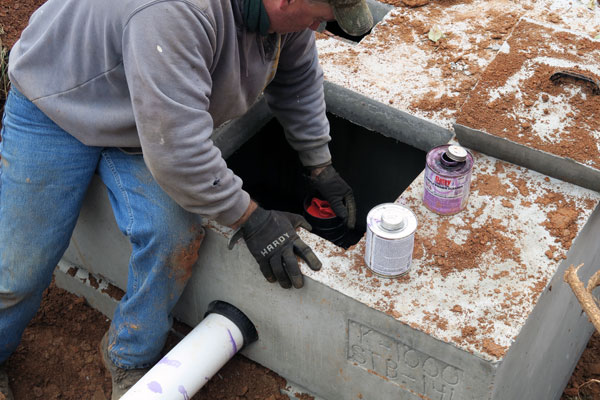 What is nice about this process is the county maintains a list of active certified installers. You can contact them directly to get an updated list (sometimes found on their website). Whatever you do, don’t assume or take someone’s word that they are certified with the county, always check directly with the health department.
What is nice about this process is the county maintains a list of active certified installers. You can contact them directly to get an updated list (sometimes found on their website). Whatever you do, don’t assume or take someone’s word that they are certified with the county, always check directly with the health department.
I’d start with people listed close to your area, then work your way out from there. Call each person and trust your gut. It’s important to realize that the good installers are busy installers, so they may have to call you back or often they’ll answer their phone while running a track hoe. My installer asked a few questions then had me call his wife to schedule a time for a site visit.
With that said, look for people who are responsive, polite, organized, and time efficient. Schedule a time to meet each of them at the location and be wary of people who give quotes sight unseen. Shoot to have three quotes from three different people who you feel good about. That means you’ll want to have 5+ estimates from different people because you’ll naturally weed out some due to being late, not showing or something else that leaves you uneasy.
How Much Does A Septic Tank Installation Cost?

When I started looking into septic system installations, cost was my number one question, but answers were not easy to find. There is a lot of variability in the cost of a septic install, so I’ll share the price and details of my system. I also wanted to outline some of the factors that impact the price and then share examples from others I surveyed to get a complete picture.
Factors That Impact Cost Of A Septic System

There are several things that impact how much your system is going to cost. It’s important to remember that while a portion of the price will be impacted by materials (largely commoditized and pretty similar costs across all your quotes), labor will be the biggest swing here. Labor costs are variable and can change based on how busy the installers are, how much of a pain they expect you or the job to be, etc. Permit costs in your area are what they are, so that will be the same across the board.
Try to ask around and see if there is a slow season or ask the installer if there is a time that you could wait on for a reduced price. Sometimes just being flexible and willing to wait will provide an opportunity to save some money. The installer may finish another job early, the inspector may be slow on another job or there could be a cancellation.
The Cost To Install My Septic

My septic was a 1000-gallon cement tank with 300 feet of drain line in a well-draining soil. My permit was $350 and I spent $300 for a guy to come out with a backhoe and dig pits for my perk test. I made sure to have this done before the purchase of the land, my offer was contingent upon successfully getting a well and septic permit.
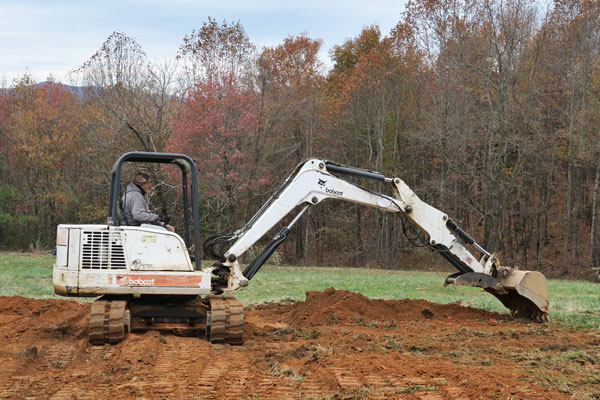 I had the system designed for 4 bedrooms because I don’t know exactly what I want to do. Most likely I’m going to have a Master bedroom and a guest bedroom, then space to put two more bedrooms in the future (I’d finish them if I sell to increase resale value). My land is located in the mountains of NC which is pretty rural and low cost of living.
I had the system designed for 4 bedrooms because I don’t know exactly what I want to do. Most likely I’m going to have a Master bedroom and a guest bedroom, then space to put two more bedrooms in the future (I’d finish them if I sell to increase resale value). My land is located in the mountains of NC which is pretty rural and low cost of living.
I chose this place because it had minimal building codes, no HOA or restrictions, and the county was pretty inexpensive tax wise. I say this for you to know that my scenario was the cheaper end of the spectrum. The one thing working against me was I had no contacts in the area at all, so I did my best to get multiple quotes.
In the end I think I ended up spending more than I had to, but I got very close to what others were paying at the time. I was on a time crunch as my permit expired at the end of the year, so I couldn’t delay things. After three quotes I settled on a contractor that I liked for $7,500 all in.
Cost To Install Other Systems

I took some time to get a better picture of costs by talking with several other people. Here is a breakdown of what their systems cost when they installed their septic system.
Louisiana
$7,000
- 1,000 Gallon Tank
- 5 Bedrooms
- 400 Feet
- Installed in 2015
California
$30,000
- 1,800-Gallon Tank
- 4 Bedrooms
- 350 Feet
- Installed in 2020
Tennessee
$3,500
- 1,000-Gallon Tank
- 3 Bedrooms
- 230 Feet
- Installed in 2012
Ohio
$7,000
- 2,000 Gallon Tank
- 4 Bedrooms
- 500 Feet
- Installed in 2004
Texas
$5,000
- 1,000-Gallon Tank
- 4 Bedrooms
- 300 Feet
- Installed in 2013
Oklahoma
$3,600
- 1,000-Gallon Tank
- 3 Bedrooms
- 400 Feet
- Installed in 2007
Nevada
$7,500
- 1,250 Gallon Tank
- 3 Bedrooms
- 500 Feet
- Installed in 2005
California
$8,500
- 1,500-Gallon Tank
- 3 Bedrooms
- 275 Feet
- Installed in 2019
Washington
$5,000
- 1,000-Gallon Tank
- 2 Bedrooms
- 300 Feet
- Installed in 2018
Michigan
$8,000
- 1,500 Gallon Tank
- 4 Bedrooms
- 3 900-Gallon Dry Wells
- Installed in 2019
Your State
Your Cost
- How Many Gallons?
- How Many Bedrooms?
- How Many Feet of Drain Line?
- When Was It Installed?
How To Install A Septic Tank System + My Installation Process

Installing a septic tank is pretty straight forward, they’re fairly simple systems. However, there are a lot of little details to get right and it’s often not something someone wants to attempt on their own if they’ve never done it before. Assuming you’re hiring someone to install it for you, talk with your county first to understand their process and requirements.
Talk With Your Local Officials

The nice thing about building in the countryside is code officials are much easier to work with than in the city. I’d suggest calling them and asking for details about the process, what it entails, and the order in which to complete the steps. Usually it starts with a perk test to get a septic installation permit.
They’ll come out and perform a soil drainage test called a “perk test”. The results of the perk test will let you know what size and type of system you’ll need to install. They’ll include that info on the permit.
Get Your Permits

You’ll need to get all your paperwork done and permit in hand before you even talk with contractors. They get a lot of calls so they often won’t work with someone until you have that permit. Getting a permit can take time: between wait times, scheduling a perk test and going rounds with officials, it took me about 60 days.
One word of caution I’d offer is don’t take anyone’s word that a permit has been issued, have the county provide you an official copy of the permit directly. I learned this the hard way, another story for another day.
Talk With Local Contractors

Follow my advice about choosing a certified septic installer (I talked about this above [hop link]). You want to get at least three quotes from people who seem like they’d be good to work with and have actually come to the location.
Get Clarity On The Process

Ask your installer these questions and then reach out to the health department and verify the process.
- When do you plan to start work?
- How long will the work take?
- What things would cause a delay?
- What things could you encounter that would increase the price? (rocks etc.)
- When will the inspection happen?
- How and who will trigger the county to schedule the inspection?
- What happens if we fail the inspection?
- What happens if we pass the inspection?
- What do I need to get from the county after this is done?
Set Expectations Up Front With Contractor

An ounce of prevention is better than a pound of cure, so getting crystal clear up front with your installer is important. Have a conversation about these items below so you know what will happen, when it will happen and what happens if it all goes wrong.
- Can you provide copies of your profession licenses, copy of your insurance policy etc.?
- Can you provide a basic contract/warranty info ahead of time?
- What is the best way to communicate with you?
- What’s a reasonable turnaround time to expect a call back?
- How much notice will I get when you’ve finalized a date to start work?
- Do you want to be present during the work or not? Make that clear
- When and how will payments be made?
- Who is paying for materials? Equipment Rentals?
Septic System Layout

The day of the installation should go pretty smoothly. Most of these installers are busy and they have the process down pat. Usually they’ll start by laying out the runs with a laser level, it’s technically possible to do it without one, but any professional should be using a level like this.
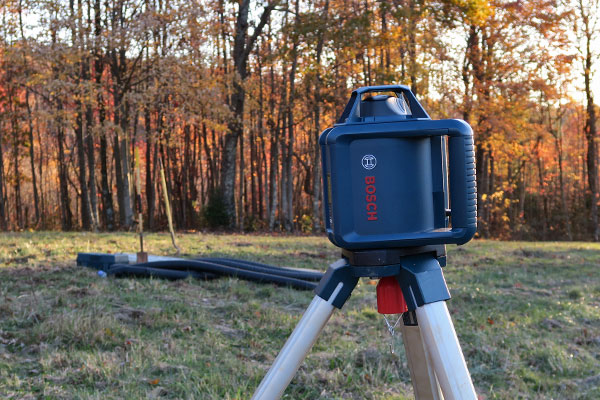
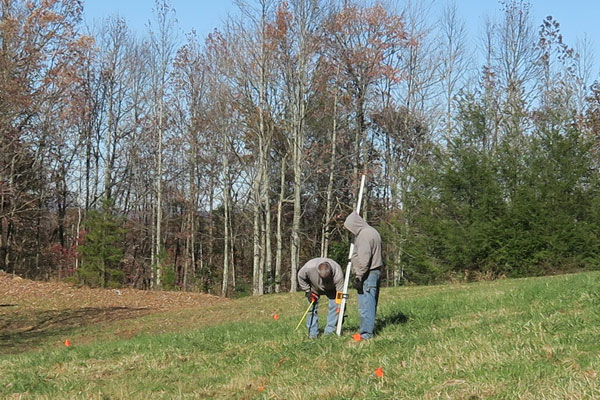
The goal here is to run the lines along the contour line of the land, so that the lines are running 1/8th to 1/4th of an inch downward slope per foot. This is all going to be oriented and placed to where you want your future home to be, so make sure you are clear on that. You usually need to be 15 feet from the house, but it varies by local codes.
Digging The Septic Tank Pit

Next, they’re going to start digging the hole to drop your tank into, this should be above the leach field unless you have a pump or more complicated system. This hole will depend on the size of your tank, but usually about 8-10 feet deep. You want to watch the installers to make sure they check that the pit bottom is level once they’ve removed the material. The goal here is to have a reasonably level tank when they drop in the concrete or plastic tank. I think if I could do it all again, I’d ask them to have some sand or gravel to put as a base at the bottom, but that might be overkill.
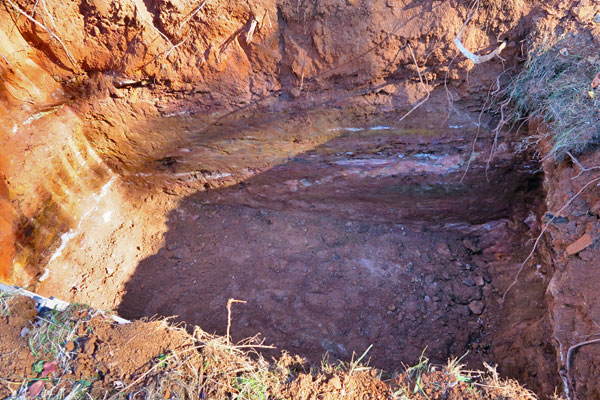
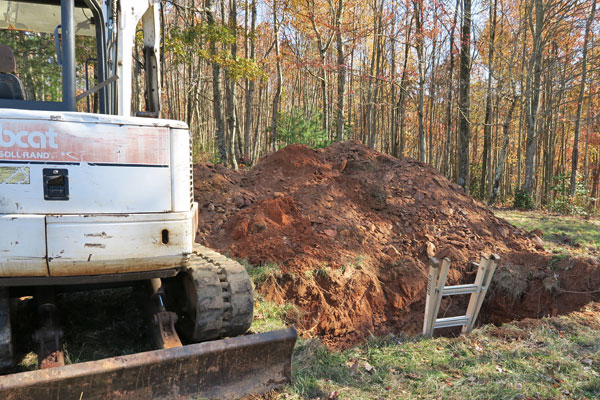
Digging The Leach Field Trenches

Depending on several factors, they will either drop the tank in right then or start digging the trenches. During my installation, the tank delivery truck wasn’t coming for a few more hours so they kept digging.
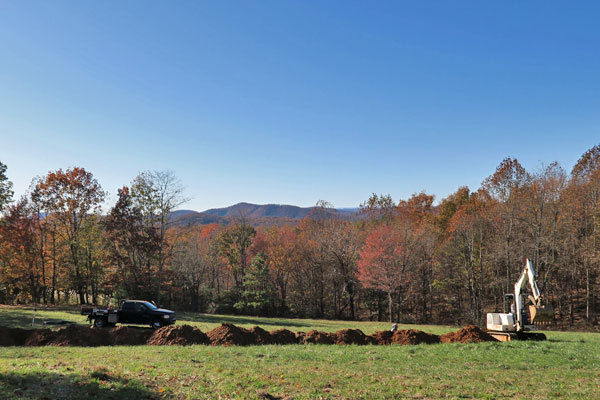
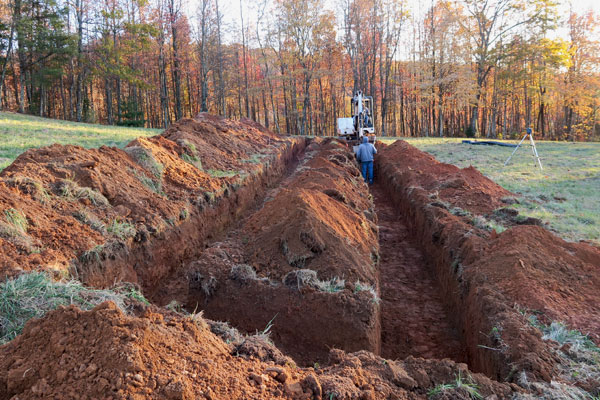
This is where my contractors really showed their skill. The little backhoe they ran was a decent sized machine and the guy running it was able to get that slope of ¼ inch per foot with impressive accuracy. The other guy used the laser level and a grade rod to check the trench the entire way.
He also picked out larger rocks to prevent damage to the drain lines and used a hand shovel to smooth the bottom of the trench to be a consistent down slope.
Repeat For Each Of Your Lines

Next, they created additional trenches to get the required length, all the while picking out rocks, smoothing the trench floor and checking for the slope all along the length.
Install The Septic Tank

At that point the delivery truck showed up with the tank and the drain lines. The truck had a built-in trestle arm that extended off the back of the truck to lower the tank into place.
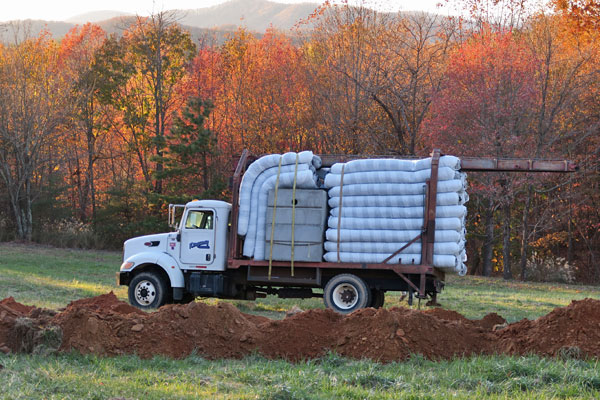
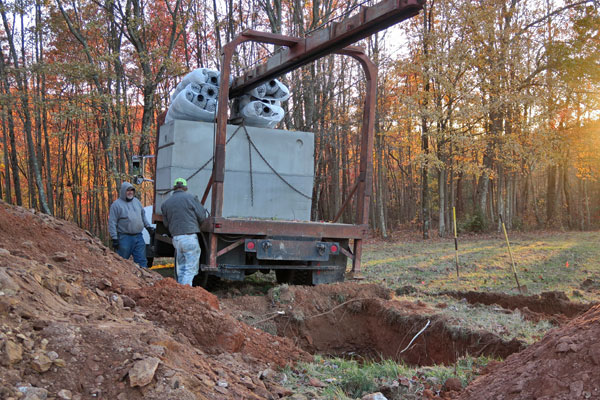
They lowered the septic tank into the ground and checked the level of each corner with the laser level again.
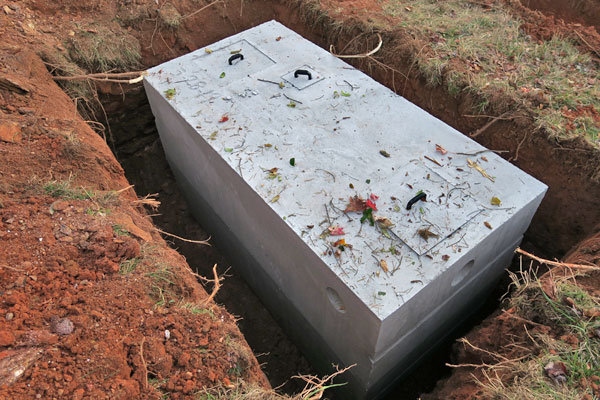
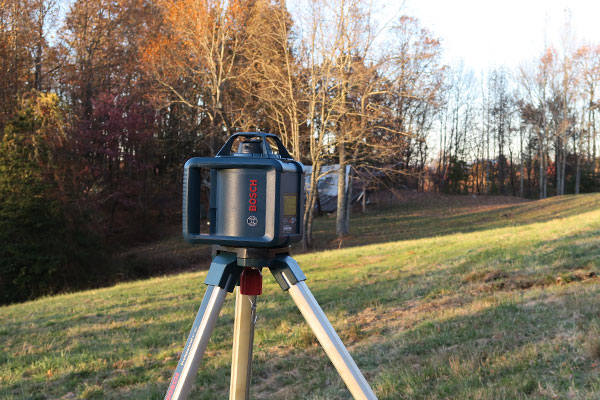
Installing The Drain Lines

The drain lines were an EZ-Flow or EZ-Drain style line. Basically, a corrugated drain line with perforations in it, surrounded by packing peanuts and held tight with a netting cover. After talking with a lot of people, this style has a pretty good track record and makes for quick installation. I’ve heard some bad reviews of the EZ-Flow style lines, but they were pretty few and far between, often with some other mitigating circumstances.
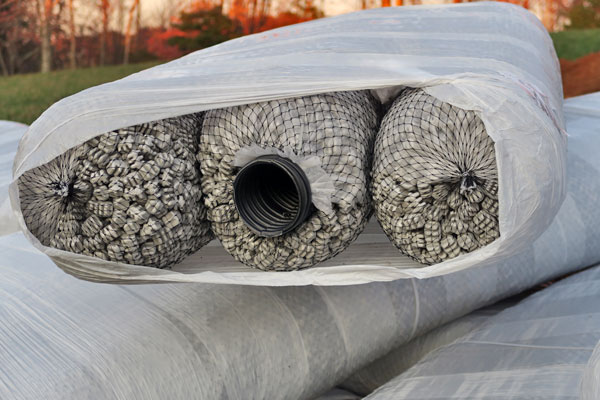
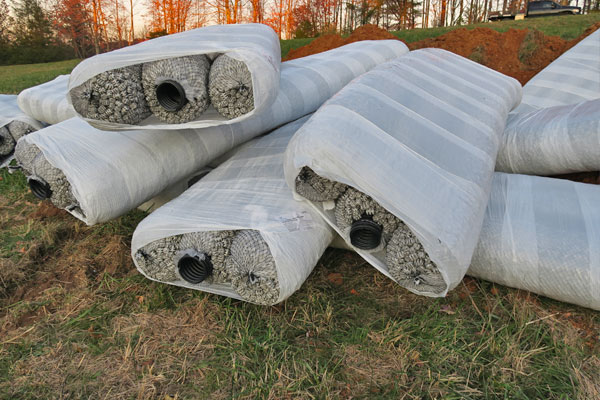
EZFLOW drain lines – Note: remove white cover before installing
It’s important to make sure your installers put the lines in the correct way. The little sausages have a filter fabric cover the top half of the line, you want that on top so it screens dirt from getting into the lines and clogging it. The bottom half is not covered to allow for better drainage. Make sure that filter fabric is on top!
The lines come in a bundle as a set of three: a center drain line and two buffers on either side of it. This helps keep the dirt from getting in too close, allowing for increased drainage once buried.
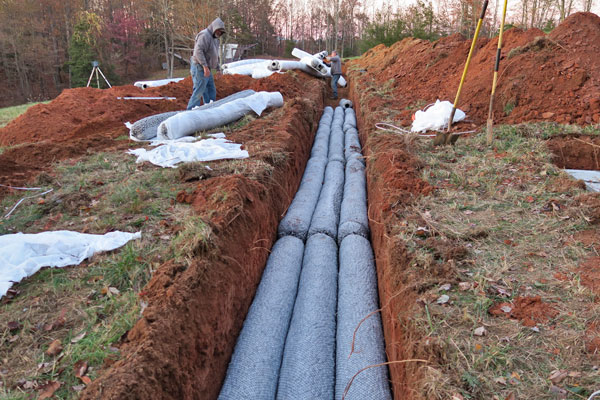
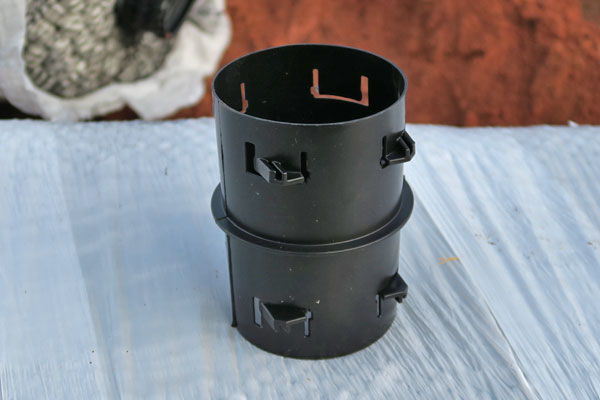
This process went really fast. The sections were very light and they connected easily with the drain line couplers. Only the middle line needs to be connected because the two outside tubes are just spacers.
One final note is the importance of not driving any heavy equipment over these lines. A smaller truck or a smaller bobcat is fine, but nothing bigger or you’ll crush the lines. Make sure you know where they are and have the area fenced off during construction.
Connecting The Tank And Drain Lines

Once everything was laid out, they moved on to connecting it all up. It was a mix of semi flexible lines and PVC pipes. They again ensured the lines had the right slope to make sure the liquids flowed correctly.
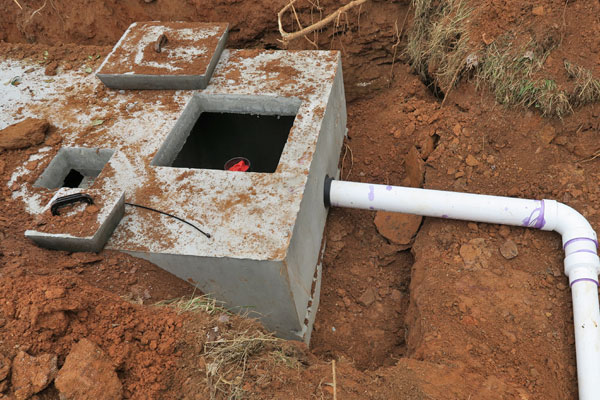
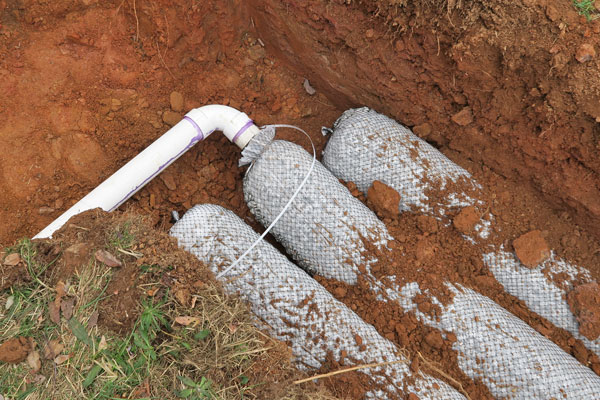
It’s important to note that at this point everything should be totally open because the inspection requires an open pit. The inspector showed up at this point for me, so some of the photos are after the inspection and partially buried.
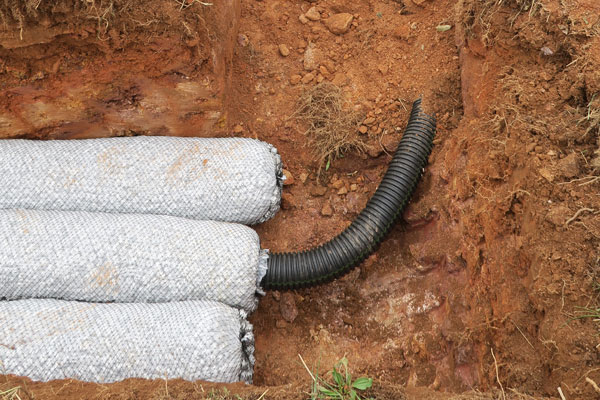
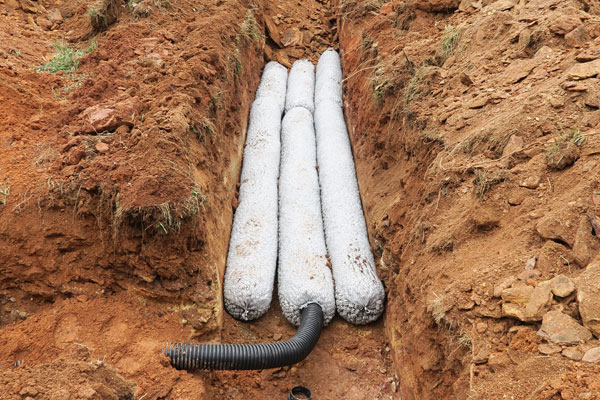
Install The Septic Filter

Inside the tank there is a hard-plastic filter that screens out solids of a certain size from entering the drain lines. You’re aiming to only have liquids flow out of the system into the lines. This should be pulled out and cleaned off each time you have your tank cleaned, roughly every 3 years.
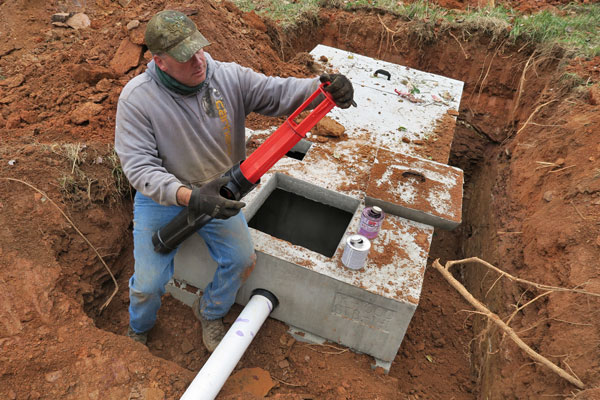
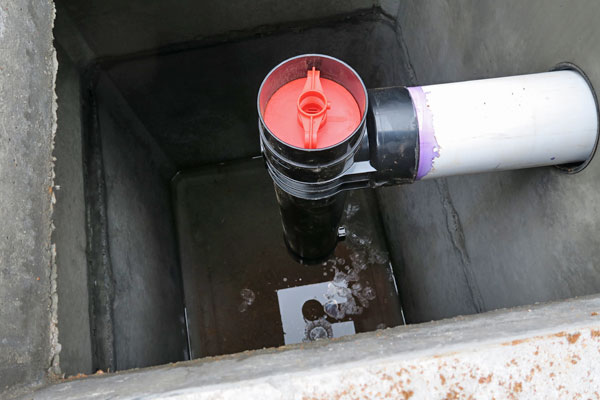
Get Inspected

This process was pretty painless. The inspector showed up and used the laser level to check the slope, looked at the connections, reviewed the permit and plot map, then signed off on everything. My installer informed me that the inspector doesn’t rake them over the coals as much as he used to when they first started. Your inspection might be more involved, my inspector told me he never had any issues with the systems these guys installed, even years later.
Mark The Tank Inlet

I hadn’t thought about this, but when I build my house, I’ll need to actually connect the tank. My installer used a board to cover the opening of the tank to block dirt from getting in and also to make it really easy to find the opening when it came time to connect. This simple thing saves a lot of digging in the future.
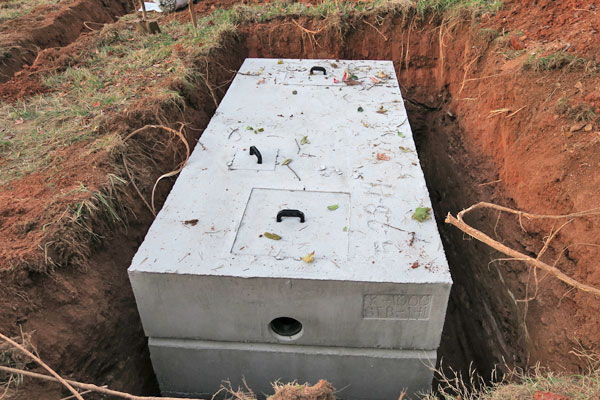
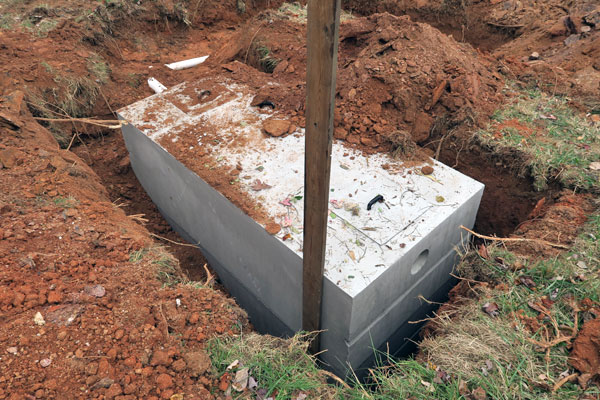
Fill in the Holes

Next was putting all the dirt back in, but only after your inspection is complete! This part is pretty simple, but as you do it, make sure you don’t have any large rocks sitting on the lines. My installer followed the bucket and picked out rocks as they went. I was glad to see their attention to these details.
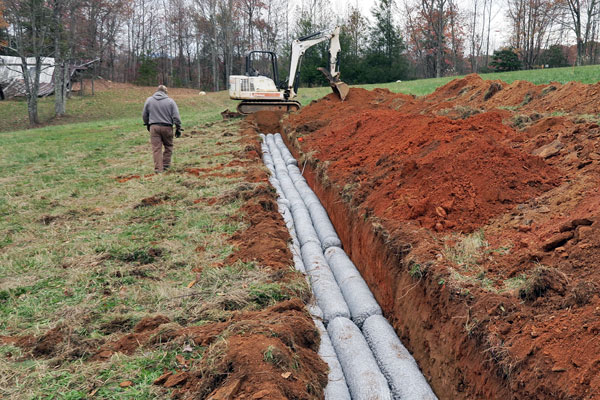
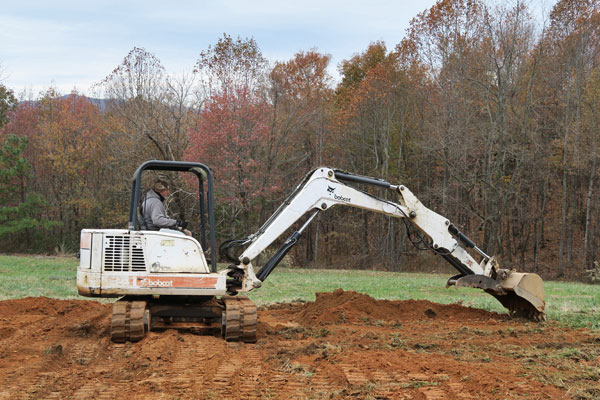
Smooth Out And Final Grading

You most likely will have some left-over dirt, so I had them just spread it out over the space. Figuring that the soil will settle a little bit over time, I figured adding a little on top would be just about right.
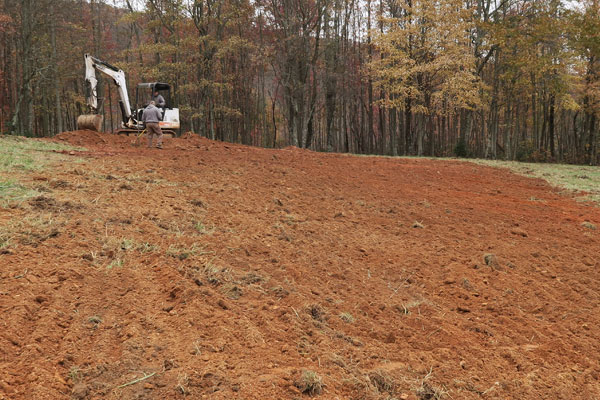
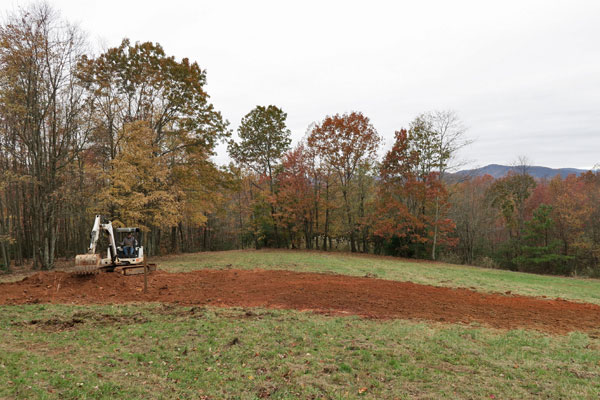
Get Your Documentation From The County

The last step is to make sure you get everything you need for the septic for future use. This usually takes a few days to a few weeks, but it’s really important to get the documents.
Septic System FAQs

Concrete Vs. Plastic Septic Tanks
Plastic tanks may be used in some areas and are sometimes preferred because they’re lighter. This makes them easier to install. The downside is they can be more easily damaged during installation and have been known to sometimes “float” up. Concrete tanks are heavy and stay in place. The delivery truck used for mine came with an arm to lower the tank in, so installing my concrete tank wasn’t too difficult.
How Long Will A Septic Last?
Typically, septic tanks will last 40+ years if installed correctly and properly maintained. Your mileage may vary depending on a lot of circumstances.
How Much Is A Septic Permit?
Permits typically start at $300 and can go into the thousands. Areas with high cost of living, more environmental review and tricky soils will cost more.
Will A Septic Tank Work Without Power?
In general, yes unless you have a pump as part of the system. Most systems rely on gravity, so the draining is a passive process.
Can You Use Bleach In Your Septic Tank?
In moderation, it’s possible to use bleach, but not highly recommended. A Septic tank operates on live bacteria cultures breaking things down. Bleach can kill those cultures. A small amount of bleach diluted among thousands of gallons will not be a big deal, but it should be used sparingly. Try to space out the use of bleach and use alternatives, like baking soda mixed with bleach.
How Often Should I Get my Septic Tank Pumped/Cleaned?
In general, you should get your septic tank cleaned every 2-3 years based on use and assuming proper design. If your septic tank is under sized then you should consider doing this more frequently.
How Much Does It Cost To Clean A Septic Tank?
Typically, you can expect to pay between $300 and $500 to have your tank cleaned.
Can You Install Your Own Septic Tank – DIY Options
Yes! In some cases, municipalities allow for owners to install their own, but realize you’re still subject to inspections etc. Some places will not allow it unless you’re licensed/certified. Installing your own system shouldn’t be taken lightly and speaking frankly, unless you have done them before or do similar work, I wouldn’t suggest it. Running the equipment to dig, getting the slopes just right, connecting things up and using the right materials are all important.
Your Turn!
- How much was your system? Include size, run length, location, bedrooms, and year installed.
- What tips do you have for getting a septic system installed?
 What is A Septic Tank
What is A Septic Tank How Much Does An Install Cost
How Much Does An Install Cost Septic System Layouts
Septic System Layouts Do I Need Permits
Do I Need Permits How To Install A Septic Tank
How To Install A Septic Tank Septic System FAQs
Septic System FAQs
Ryan, thank you for this hugely insightful article. Homeowners rarely want to get their “hands dirty” when it comes to the topic of human waste disposal but it can obviously be a critical component of any house using a traditional waste system (which still tends to be the majority of homes on permanent foundations). Happy to see someone less shy about getting into the septic trenches and drilling down on so much helpful info for the rest of us. Thanks again!
This article was excellent! Very informative!! Thank you!
Ryan, Good stuff! This was one of my big learning items, so i’m sure it will be hugely helpful to many folks. I, too, have found my land in the NC mtns (watauga co) after 5 years of searching. Sounds a lot like your place and plans: small cottage, big garden, orchard… The home site is on a kinda rocky hill, so that increased the costs. I heard horror stories about the County approval process, so opted to pay a little extra for a “session law” soil engineer / perc test that got the layout and County approval done smoothly. That ran $2k. $400 for digging perc holes, as they hit a lot of rock and had to dig 2x as many as they hoped. Boone Health Dept well and septic permits were $850, and the full site clearing and grading, 100 yard long gravel drive, fully installed septic system (3br) ran $22k. it’s about 80 yards from the cottage down to the end of the septic field.
I would have much preferred a composting toilet and grey water system, but permitting on those is very difficult and pricey.
So ironic that you posted this when you did. I bought land 3 years ago, had it perc’d for a 600 sq/ft home, the county gave me the go ahead. Had it cleared last summer. Now, I am at a complete stand still. The septic est. is 7500k since I need a lift station and I have no clue how to negotiate the cost of a well. I went out there today and just sat and tried to figure out where to go from here. Soooooo overwhelming.
Hey, Hoping you’re still not stuck, but see it’s not too long since you’ve posted. Just thought I’d help as much as I could through the internet…
While I’m not in the biz anymore, I used to do Land Surveying and worked at a Engineering firm a few years back. You might want to see if you can contact a local Civil Engineer or Land Surveyor. Also, talk to your county office planning and permitting officials. They’ll also be able to give you specific guidance here if you’re still stuck. They’ll have local contacts available, and be the best for indicating estimate costs, and reviews of contractors.
Best of Luck!
I am thinking of purchasing land for a tiny home and this was an eye opening to the other costs that will accrue when planing for my future tiny home ownership. Thank you so much for this insight. Good stuff.
In addition, an unpermitted installation of a septic tank can make a home difficult to sell and insure. Working with a professional is the best way to ensure that the septic tank is permitted and safely installed.
I had some experience designing septic systems back in the 80’s. Things have changed quite a bit since then. We bored holes with an auger to check soils, then poured water in a hole and timed the perc rate. Good times. One thing that needed to be considered was where the well is. Most counties have a minimum distance between the well and septic field. Something to consider that was not mentioned in the article.
I like how you mentioned that most areas require you to hire a certified installer to install a septic system. My brother is thinking of hiring a septic system installation specialist because he’s considering building a house that’s many miles away from the nearest city and won’t be able to use a traditional sewer arrangement for his home. It seems like a good idea for my brother to think about hiring a reputable professional to help him with his wastewater treatment structure if he decides to build the house.
Hi, I found this to be a really good starting point for this topic for those considering having a system installed. It’s been many years since I’ve work in Land Surveying or Civil Engineering, but thought I’d offer a few things to consider after reading some of the comments…
– Always start at your county/town officials where you get permits. Not only will they have a list of licensed people, but many will also have a better idea of whom does good work. I’ve found this is crucial to start especially when you’re coming from out of the local area.
– Also while you’re in the office, look up recently completed permits and permit plans. The better firms and Engineering Offices that file these will have not only the design specs written, but also detail drawings to show what will be installed, (X” sand, X” stone, elevation and setback constraints) that may provide better details on what you should be looking for when talking to contractors. Sometimes notes will be added to show where issues arise and how the plan is going to accommodate modifications for these issues. The point is you don’t need to understand every detail, but just get an idea of how complete the firms were in doing their work, and possibly provide some option may be available in case of issues during the build process. Also, find out if you can get a copy of the septic requirements, should cost a few bucks but detail what the county will require when inspecting.
– If you think you’ll be driving over you leaching fields on any basis (or even unregular basis), or pulling your heavy loads over them, consider installing ‘concrete galleries’ in addition to the leaching lines. These are typically tee-pee shaped concrete structures that are installed with the leach pipe just below the peak of each line, and add more protection for shallow leach fields, or just if you feel you’d likely end up driving over them. While they are an additional cost, they will end up saving you a headache from the cost of repairs later. Again, not a cheap addition, but one you should be aware exists. If your system is deep enough, this should not be necessary for very infrequent drive overs.
– Make sure you are present when you get your tank pumped. Not only might there are some unscrupulous people who may charge you and not do the job at all, but especially for the first pump or two, you can discuss with the person pumping if the content look correct (too much solids, or floating materials) and adjust your usage and pump/clean cycle accordingly.
– If you really wish to maintain the systems biotic health, try to keep grease, oils, and other floating things, as well as bleach and other cleaners from going down the drain. If enough grease builds up between your clean cycle, they can end up in your leaching lines/fields and cause clogs which result in repair (or replacement) costs. Bleaches and cleaner will do much damage to the bacteria needed to keep things working as designed.
– Add a quart sized can of bakers yeast to the system (flush it down the drain) once a year or so. This will keep the bacteria happy in your septic tank, and mitigate some of the harmful stuff you or your family might end up placing in the system. I got this tip from an installer many years ago, and AFAIK works well and is easy cheap addition for your system plan.
Everything posted was actually very logical. However,
think on this, what if you composed a catchier post
title? I am not saying your content is not good, however suppose you added something that
grabbed a person’s attention? I mean How To Get A Septic Tank Installed – My Septic Install: Costs,
Advice, Details And More | The Tiny Life is kinda plain. You could
peek at Yahoo’s front page and see how they create post headlines
to grab people to click. You might add a video or a related pic or two
to get people interested about what you’ve written. Just
my opinion, it could make your website a little bit more interesting.
I appreciate you for helping me learn about septic systems. My aunt wants to install one in her property now that there’s an increase in the family size. With that considered, I shall then consider hiring a certified septic installer who has spent years of experience in the field.
My husband and I are planning to have a septic tank installed in our home because this may help increase our property value. Well, it’s a great thing that you were able to elaborate here that the permit is necessary because we’ll have a difficulty in selling our home without the proper documentation. Thank you for also elaborating here that the location will affect the installation cost.
thanks for the advice to have your septic tank downhill of your home and the drain lines downhill of the tank. I have been looking to get a septic tank for a while now. It’d be nice to have it placed in a convenient spot too so pumping would be easier.
I bought a 2 bedroom trailer on a small piece of land in a rural town in PA. The first thing i did was to contact the local septic system company. The came out to the property on a Saturday morning with a scope and a sonic device and located the cesspool (no drain field).
They told me that many of the systems in PA are grandfathered in. As long as there has been a building on the property and no one complains, then, nothing is done. They suspect that many properties still have the old metal tanks which may be rusted and leaking.
With the work they did and the recommendations for future improvements, the bill was just over $700.
Thanks for sharing this informative blog post. This is such a very detailed blog and taught us every detail we need to know when installing a septic tank. Thanks for the wonderful advises.
Patricia
Check this out
My tank is very similar to yours. The difference is I have a cast concrete baffle on the outlet side preventing installation of an effluent filter.
1. It’s there anything I can do about that?
2. What is the smallest lid for? I have the same one with something like a (horizontal) baffle just like yours.
Oh my gosh! Thanks so much for being so thorough. I am now searching for raw land rather than buying only God knows what problems in an existing AND over-priced home in this current crazy insane real estate market. You simplified explaining the process and that was truly what I wanted to know. You also gave me a ball park $$ amount to pencil in too.
I have saved this information for future reference.
This is a really good and detailed post, well done, thanks for making this
This is an old thread so I doubt I will get an answer. I had my septic put it for $5K in Texas. The installers agreed to come out and hook it up to my tiny home when it arrived. I can’t get them to do the hookup part. It’s been about a month now and they won’t answer me after one text saying they would go take a look at what I need. How do I get them to do the work? File with the better business bureau? I seem to have no power over them. Do I file a small claims court lawsuit?
Thank you for the great information. I had no idea how much went into installing a septic system. We received a quote a couple 2 years ago for $7,000. Now the quote is $12,000. Yikes!
Thank you so much for taking the time to detailed the posting. This is extremely helpful. Thank you! Thank you!